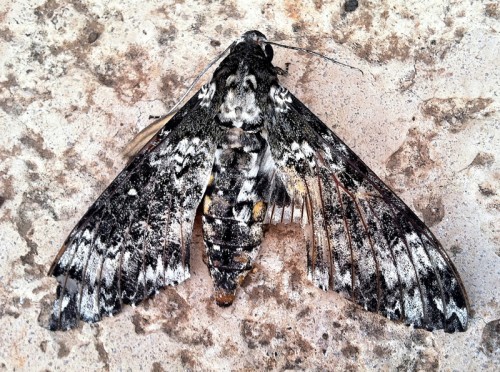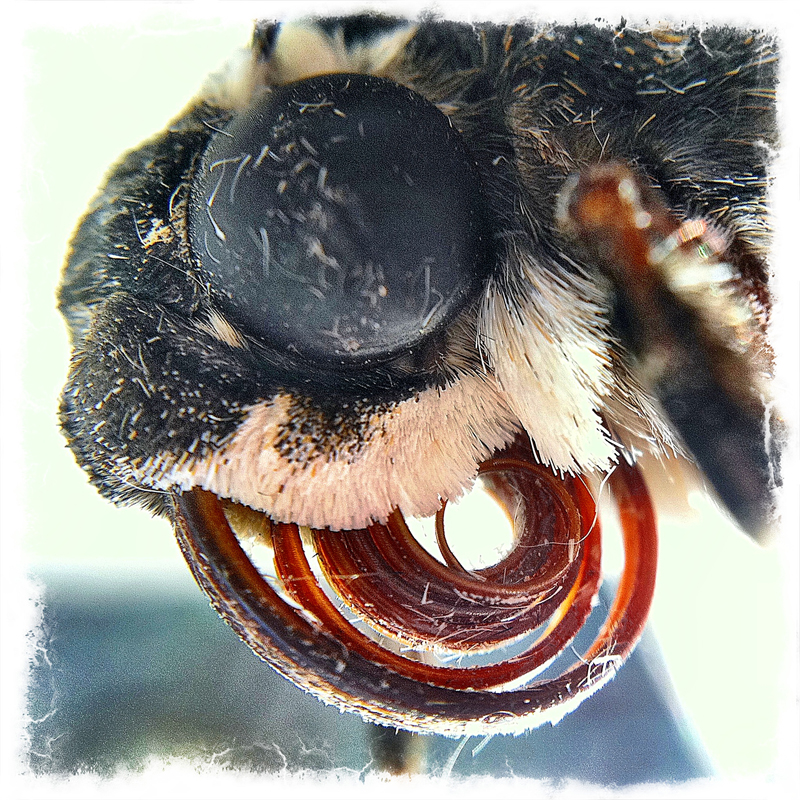Face of a Sphinx
The morning after our latest haboob I found an expiring Sphinx moth, battered by the winds and on its last legs. It was a big one, not as colorful as some, but marked like bark in black and white, with three orange spots on its abdomen. It’s a fairly large animal: about three inches long, with an abdomen like my little finger, except segmented and furry.  I’ve identified it as Manduca rustica, the Rustic Sphinx (if you know different, please let me know), which as an adult moth feeds on deep-throated nectar flowers such as Petunias and Tecoma.
I’ve identified it as Manduca rustica, the Rustic Sphinx (if you know different, please let me know), which as an adult moth feeds on deep-throated nectar flowers such as Petunias and Tecoma.
<< Manduca rustica (photos A.Shock, click to enlarge)
Although it’s probable that this individual was done in by the wind, it may also have been at the end of its life span anyway. I carried it to the outdoor table, and took a few macro shots with my cell-phone macro lens.  That I got any results worth sharing is a bit amazing, since the lens, which is designed for a different cell phone than the one I own, has to be scotch-taped to the device. (Seriously, scotch-taped to the device, not exaggerating.)
That I got any results worth sharing is a bit amazing, since the lens, which is designed for a different cell phone than the one I own, has to be scotch-taped to the device. (Seriously, scotch-taped to the device, not exaggerating.)
Anyway, here’s the sphinx’s face, with its big night-seeing eye, its furry head, and its coiled, straw-like proboscis, plenty long for reaching down the throats of flowers for the good stuff.

That is an amazing shot. I laugh to think of your sucky-cup lens taped to your IPhone. So the Sphinx cannot store its proboscis internally, but must keep it coiled outside?
I guess the proboscis is too big to keep inside. Although, as the poor corpse dried out, the organ got more visible. Maybe in the peak of health, the moth has enough tissue to conceal it? Dunno…
Hi there! A student in our classroom stumbled upon a cocoon and brought it into class quite a few weeks ago. This morning this big guy came out. He must have just broke free right before I got to school because his wings were still very short and his body was very long. Since then (5 hours) his body has shrank a bit and his wings are fully dry. Thank you for this post. Our students were very excited to see your picture of the close up of his eye and proboscis.
Hi Kerry — Thanks for sharing your sphinx moth story. It’s very cool that your class got to watch that transition from pupa to moth. Just recently, I posted photos of another, smaller species of sphinx moth, with a very different eye and face. It’s a White-lined sphinx. Check it out here: http://threestarowl.com/natural-history/sphinx-in-pinks
I’m wondering if the difference in the eye is because the White lined sphinx is alive, and the poor Rustic sphinx wasn’t — maybe that’s why one has a distinct pupil and the other doesn’t? It also amazes me that animals without eyelids always have stuff on their eyes, and it doesn’t seem to bother them!
I just found one on my balcony. I live in Tucson, Arizona and have never seen a moth this extravagant. He must have migrated from somewhere but just don’t know where.
Barbra, I’m not a moth expert but I know Rustic Sphinx Moths are native to Maricopa County, so why not Pima County? We also have White-lined sphinxes, which are very beautiful, too. See here: http://threestarowl.com/natural-history/sphinx-in-pinks